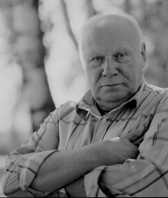"I've never had such a creative period. I seem to be led by some kind of force which dictates what I should do, and which instruments I should choose", says the composer Vytautas Laurušas, whose ample and diverse output of recent years range from song cycle for early music ensemble to cello and clarinet concertos to cello duo. The latter, Concento di corde, performed with great success by David Geringas and Nicolas Altstaedt at the Kronberg Cello Festival in Germany on Sept. 17 and recently published by Schott Publishers, is actually a new version of his like-named composition for two violas (also published by Schott). It was reworked for cellos on request by the celebrated cello player David Geringas and has become part of his standing repertoire, performed by him with different companions.
|

photo: Arūnas Baltėnas
|
Many of Vytautas Laurušas' recent works have also been composed with particular performers in mind. When he wrote
Three Images for soprano, gamba and theorbo to the texts by an American poet John Gracen Brown, he was so impressed by the performance of the Swedish Kairos Ensemble, who premiered it at the Gaida 2002 festival, that he soon decided to expand the cycle with four additional movements. Now the
Seven Images await the first performance of their full version at the concert series dedicated to the composer's 75th anniversary on Nov. 24-25 in Vilnius. The programme will also include
Concento di corde for two cellos, the cello concerto
Discorso concitato dedicated to David Geringas,
Symphony of Prayers for string orchestra (which extends the list of Laurušas' works published by Schott),
Commonplace Sonnet for tenor and string orchestra,
Bird Market for flute, violin and viola, the string quartet No.2
Variations on the Theme of My City, and one more premiere – the clarinet concerto
Leggenda. Composed for one of the most distinguished Lithuanian clarinet players Algirdas Budrys, the new concerto seems to expose different sides of the composer's idiom in a succession of contrasting sections making up a kind of abstract narrative. The orchestral writing is colourful, with healthy dose of tone clusters and various sound effects, and vivid patches of brass and percussion accents. On the other hand, it has its lyrical moments as well, centered mostly around clarinet's supple cantilena.
© Linas Paulauskis
Lithuanian Music Link No. 11

